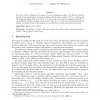22 search results - page 4 / 5 » Clique and chromatic number of circular-perfect graphs |
INFOCOM
2005
IEEE
14 years 28 days ago
2005
IEEE
Abstract— Given a wireless ad hoc network and an endto-end traffic pattern, the power rate function refers to the minimum total power required to support different throughput un...
SODA
2004
ACM
13 years 8 months ago
2004
ACM
We study vertex colorings of the square G2 of an outerplanar graph G. We find the optimal bound of the inductiveness, chromatic number and the clique number of G2 as a function of...
COMBINATORICA
2008
13 years 7 months ago
2008
A random geometric graph Gn is constructed by taking vertices X1, . . . , Xn Rd at random (i.i.d. according to some probability distribution with a bounded density function) and...
IPL
2000
13 years 7 months ago
2000
In this paper we study the performance of a particular on-line coloring algorithm, the First-Fit or Greedy algorithm, on a class of perfect graphs namely the permutation graphs. W...
STOC
2005
ACM
14 years 7 months ago
2005
ACM
We introduce a new graph parameter, called the Grothendieck constant of a graph G = (V, E), which is defined as the least constant K such that for every A : E R, sup f:V S|V |-1 ...

